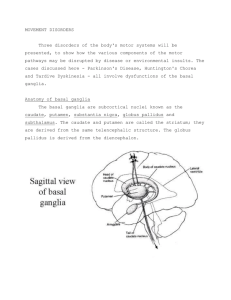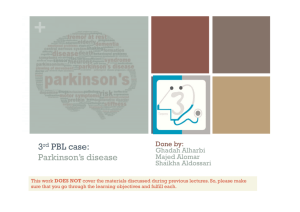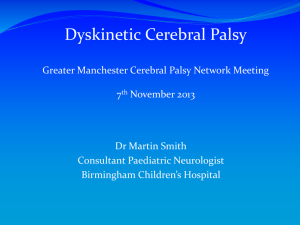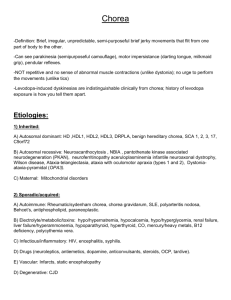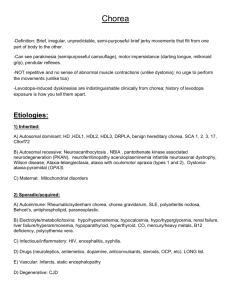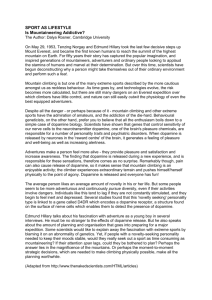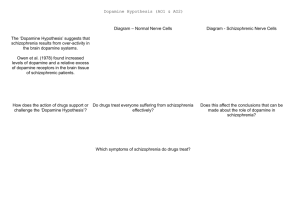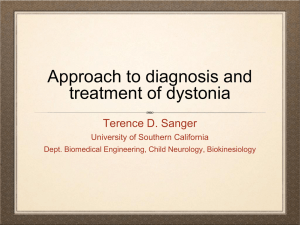Extrapyramidal System
advertisement
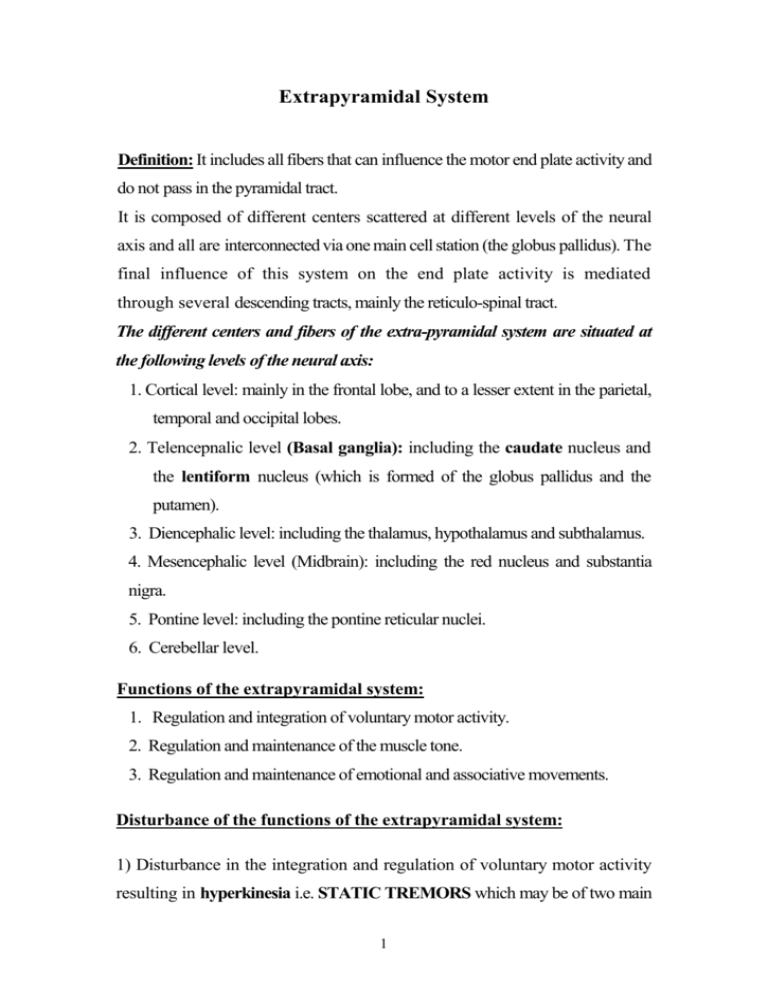
Extrapyramidal System Definition: It includes all fibers that can influence the motor end plate activity and do not pass in the pyramidal tract. It is composed of different centers scattered at different levels of the neural axis and all are interconnected via one main cell station (the globus pallidus). The final influence of this system on the end plate activity is mediated through several descending tracts, mainly the reticulo-spinal tract. The different centers and fibers of the extra-pyramidal system are situated at the following levels of the neural axis: 1. Cortical level: mainly in the frontal lobe, and to a lesser extent in the parietal, temporal and occipital lobes. 2. Telencepnalic level (Basal ganglia): including the caudate nucleus and the lentiform nucleus (which is formed of the globus pallidus and the putamen). 3. Diencephalic level: including the thalamus, hypothalamus and subthalamus. 4. Mesencephalic level (Midbrain): including the red nucleus and substantia nigra. 5. Pontine level: including the pontine reticular nuclei. 6. Cerebellar level. Functions of the extrapyramidal system: 1. Regulation and integration of voluntary motor activity. 2. Regulation and maintenance of the muscle tone. 3. Regulation and maintenance of emotional and associative movements. Disturbance of the functions of the extrapyramidal system: 1) Disturbance in the integration and regulation of voluntary motor activity resulting in hyperkinesia i.e. STATIC TREMORS which may be of two main 1 types: Rhythmic and regular as in Parkinsonism. or Dysrhythmic and irregular as in chorea, athetosis and dystonia. 2) Disturbance in the regulation and maintenance of normal muscle tone resulting in hypertonia described as RIGIDITY. 3) Disturbance in the regulation and maintenance of emotional and associated movements resulting in bradykinesia in the form of MASK FACE, infrequent blinking and loss of swinging during walking. The Extrapyramidal System 2 Parkinsonism (Shaking Palsy) It is a condition in which there are static regular rhythmic tremors associated with hypertonia of the muscles of the body and with bradykinesia. It is due to deficiency of dopamine in the basal ganglia and substantia nigra. The appearance of these signs is due to neuro-chemical changes caused by a deficiency of the neurotransmitter “dopamine” within the basal ganglia and substantia nigra . When dopamine is lacking, excessive excitatory output results in generalized activation of the skeleto-motor system by reticulo-spinal and rubro-spinal pathways. Causes: I. Idiopathic: Parkinson's disease (paralysis agitans). The cause is unknown. There is degeneration of the pigmented cells (neuromelanin) of the substantia nigra, which becomes pale. The basal ganglia are also affected. This degeneration leads to deficiency of dopamine in the brain. The age of onset is above 50 years. Both sexes are equally affected. II. Symptomatic: There is a known cause which leads to deficiency of dopamine in the brain, but without structural changes in the substantia nigra or basal ganglia. 1. Inflammatory: Encephalitis. 2. Vascular: Cerebral atherosclerosis. 3. Toxic: Co or Mn poisoning. 4. Neoplastic: Tumours of the basal ganglia. 5. Traumatic: Repeated trauma to the head as in boxers. Clinical Signs: 1. Tremors: 3 Tremor is defined as involuntary, rhythmic alternating bursts of movement of antagonistic muscle groups, occurring at a rate of about 4 to 8 oscillations per second . It is described as a static, non-intention tremor. It is theorized that tremor results from enhanced activity in the basal gangliathalamic-cortical circuit , with resultant rhythmic discharge of the alpha motoneurons by the ventro-lateral nucleus of the thalamus . It begins unilaterally in the U.L. and spread to all 4 limbs. It gives the hand the pill-rolling posture with the thumb moving rhythmically back and forward on the palm. They increase with emotional stress and fatigue and disappear during sleep and voluntary movements. 2. Rigidity: Rigidity may be defined as an increased resistance to passive motion which affects all striated muscles . It represents an increase in static stretch reflexes and excess activation of alpha motoneurons in both agonist and antagonist muscle groups. limbs resulting in the gorilla-like attitude. It may be present throughout the act to the same degree & is then described as lead pipe rigidity; or may be interrupted by the tremors & is then described as cog wheel rigidity. It affects more the flexors of the neck, trunk. It causes difficulty in starting the act of walking leading to a slow, shuffling (festinant or short steppage) gait with propulsion. Loss of reciprocal arm swing during gait may be due to truncal rigidity. It affects the proximal more than the distal muscles. 3. Bradykinesia: Bradykinesia refers to the difficulty in initiating movement and the slowness and paucity of movement that these patients exhibit. Voluntary and automatic movements are reduced in speed, range and amplitude (hypokinesia). A considerable time often elapses between patient's 4 desire to move and the actual response (reaction time). Similarly, the time it takes to complete an activity is also increased (movement time). Moreover, overall coordination is impaired, particularly in fine motor tasks such as writing or handling small objects. Bradykinesia is theorized to result from a lack of integration of sensory information by the basal ganglia with a resultant alteration in motor planning and facilitation of movement. 4. Loss of emotional and associative movements: resulting in: - Immobile face, with frequent blinking (mask face). - Monotonus speech. - Loss of swinging of the arms during walking. 5. Other clinical signs may be found in some cases (mainly post-encephalitic): 1) Oculo-gyric crisis: sudden spasm of the conjugate movement of the eyes, mainly upwards. 2) Greasy face and sialorrhoea. 3) Diabetes insipidus. 5) Impotence or amenorrhoea. 6) Glabellar reflex. 4) Obesity. 7) Pyramidal signs. The commonest causes of Parkinsonism are: 1) Paralysis agitans. 2) Post-encephalitis. 3) Atherosclerosis Features Age Paralysis agitans 40-60 years Post-encephalitic Any age Atherosclerosis Over 60 years Onset Gradual Usually acute Gradual Course Progressive Regressive or stationary Remissions & Rigidity Tremors more than Rigidity & tremors exacerbations Rigidity more than rigidity equally marked tremors Oculogyric crisis, Hypertension, Possible associated Greasy face, Sialorrhoea, Diabetes mellitus, features Diabetes insipidus Pyramidal Pyramidal signs. signs.Coronary heart disease. 5 Treatment: I. Medical The manifestations of parkinsonism are due to an imbalance between the levels of acetylcholine and dopamine in the basal ganglia and substantia nigra. Reduction of dopamine and relative increase in acetylcholine levels are found in all cases of parkinsonism, whatever the cause. Therefore medical treatment aims to restore the balance by decreasing acetylcholine or elevating dopamine levels. 1) Anticholinergic drugs. 2) Levo—Dopa: (Dopamine precursor). As dopamine does not cross the blood-brain barrier, its precursor levodopa, which can cross it, is used instead. 3) Levo-Dopa + Carbi-Dopa: (Sinemet) It was found that L-dopa is, to some extent, decarboxylated in the liver to dopamine before crossing the B.B.B. resulting in: - The appearance of side effects due to the peripheral action of dopamine. - The necessity of using large doses of L-dope to insure the passage of an effective dose across the B.B.B. These disadvantages are reduced by the addition of Carbi-dopa which inhibits the extracerebral decarboxylation of L-dopa to dopamine. Carbi-dopa itself does not cross the B.B.B. N .B: Sinemet is best prescribed for rigidity and bradykinesia. On and off phenomenon: After long term treatment with L-dopa, the patient may show signs of Parkinsonism (under treatment) alternating rapidly with signs of drug overdosage, mainly Chorea (overtreatment), as if being turned "on and off." The dose of L-dopa should be reduced and other drugs are given. 6 4) Dopamine agonists: They mimic the action of dopamine at receptor sites. 5) Amantadine hvdrochloride (Symmetrel): It prevents the uptake of dopamine by the neurones. II. Surgical Pallidectomy or Thalamotomy. Chorea Definition: It is involuntary, static, irregular, dysrhythmic, sudden, jerky, pseudopurposive movements of any part of the body, including the face, trunk and/or limbs. It is due to a lesion in the caudate nucleus. Causes: I. Herido-familial: Huntington's chorea. II. Symptomatic: 1. Autoimmune: Rheumatic chorea. 2. Infective: Post encephalitic chorea. 4. Toxic: Chorea gravidarum. 3. Vascular: Hemiballismus. III. Idiopathic: Senile chorea. Rheumatic chorea (Sydenham's chorea) It is one of the major criteria of rheumatic fever. It is associated with other rheumatic manifestations in about 10% of cases but never with rheumatic arthritis, and the sedimentation rate is usually normal. Age: 5-15 years. Sex: females more than males. Clinical picture: 1. Choreic movements: 7 a) It affects the tongue, facial, trunk and extremities muscles, being more proximal than distal e.g.: - When the patient is asked to keep his tongue protruded and unsupported by his teeth, he is unable to do so, and quickly retracts it. - Grimacing, jerking of the shoulders, shaking of the hands and feet b) The movements increase with emotional stress and disappear during sleep. 2. Hypotonia: - When the patient stretches his arms there is flexion at the wrist and overextension at the metacarpophalangeal and interphalangeal joints with fanning of the fingers giving the boat shaped or scaphoid-shaped hand. - When the patient elevates and supinates his arms they deviate downwards and laterally and become pronated. 3. Emotional instability: Sudden laughing or crying is observed in most cases. Treatment: 1. Complete rest in bed. 2. Acetyl salicylic acid. 3. Corticoids in cases of rheumatic activity or failure of the above treatment. 4. Tranquilizers and antidepressants. 8 Athetosis This is a condition where there are: - Involuntary, irregular, static, slow, snakelike movements. - They involve the extremities (especially the hands & fingers) and the face on each side. - They are associated with hypertonia. - Causes: 1.Congenital: e.g. hypoxic neonatal brain damage. 2. Acquired:Postencephalitic. - Treatment: Anticholinergic drugs. Dystonia This is a condition where there are: Involuntary, static, very slow, torsion or twisting like movements. They involve the neck, trunk & the proximal muscles of the extremities. They are associated with hypertonia during the movement & normal tone in between. Dystonia may be: I- Generalized: Dystonia muscularum deformans: it is a familial disorder which starts in childhood. Some cases respond to Levodopa (Sinemet) or Tegretol while others respond to anticholinergics. II- Partial: a) Spasmodic torticollis (wry neck): Dystonia of the sternomastoid leads to turning of the head to the opposite side, especially when the patient is walking; 9 many cases respond to anticholinergics but some may require myotomy or section of the spinal accessory nerve. b) Oromandibular dystonia: Constant involuntary prolonged tight eye closure (blepharospasm) associated with dystonia of the mouth and jaw muscles. c) Writer's cramp: There is spasm and pain of the muscles of the hand and forearm on attempting to write. D.D. of Extrapyramidal Irregular Movements Feature Chorea Athetosis Slow, snake like. Dystonia 1. Movement Rapid, jerky pseudopurposive 2. Site of movements Trunk & extremities Mainly extremities & distal, more than proximal. Mainly in the trunk & if in the extremities mainly proximal. 3. Tone Hypotonia Hypertonia. Hypertonia during movement and normal inbetween 4. Cause Commonly, rheumatic fever Congenital or postencephalitic. Familial (in the generalized type). Very slow, twisting like. --------------------------------------------------------------------------------------------------Modified from: Elwan H: Principles of Neurology.University book center, Cairo, Egypt, 2007. 10
